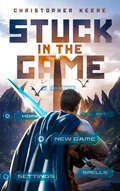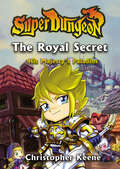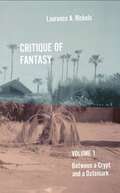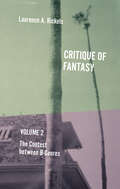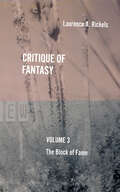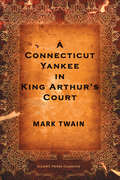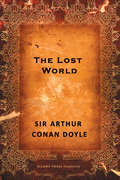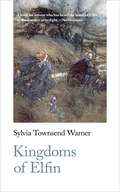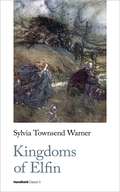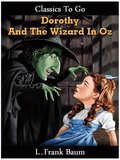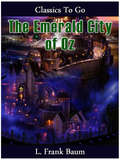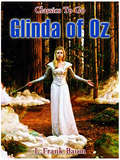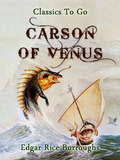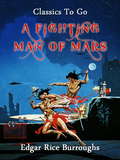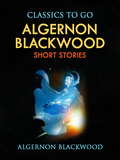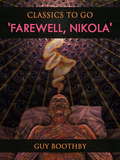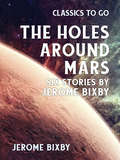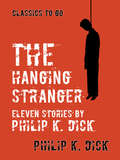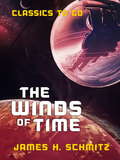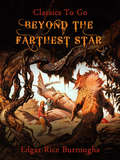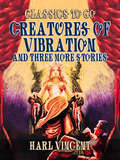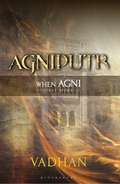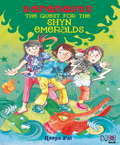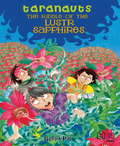- Table View
- List View
Stuck in the Game
by Christopher KeeneMost gamers would love being stuck in the Dream State—a virtual world full of thrilling quests, perilous dungeons, and wicked monsters—but for Noah, it&’s the most dangerous place he could be. Perfect for fans of video games and adventure alike, Stuck in the Game will keep you logged in until the very end!
The Royal Secret (His Majesty's Paladins Ser. #1)
by Christopher KeenePicking up where the Super Dungeon Series left off, The Royal Secret takes readers into the heart of Crystalia as Otto tries to protect his father's legacy and uncover an evil plot. This action-packed middle grade novel includes beloved characters from the board game Super Dungeon Explore.
Critique of Fantasy, Vol. 1: Between a Crypt and a Datemark
by Laurence A. RickelsCritique of Fantasy, Vol. 1: Between a Crypt and a Datemark addresses both the style or genre of fantasy and the mental faculty, long the hot property of philosophical ethics. Freud passed it along in his 1907 essay on the poetics of daydreaming when he addressed omnipotent wish fantasy as the source and resource of the aspirations and resolutions of art, which, however, the artwork can never look back at or acknowledge. By grounding his genre in the one fantasy that is true, the Gospel, J.R.R. Tolkien obviated and made obvious the ethical mandate of fantasy’s restraining order. With George Lucas’s Star Wars we entered the borderlands of the fantasy and science fiction genres, a zone resulting from and staggering a contest, which Tolkien inaugurated in the 1930s. The history of this contested borderland marks changes that arose in expectation of what the new media held in store, changes realized (but outside the box of what had been projected) upon the arrival of the unanticipated digital relation, which at last seemed to award the fantasy genre the contest prize. Freud’s notion of the Zeitmarke (datemark), the indelible impress of the present moment that triggered the daydream that denies it, already introduced the import of fantasy's historicization. Science fiction won a second prize that keeps it in the running. No longer bound to projecting the future, the former calling which in light of digitization it flunked, science fiction becomes allegorical and reading in the ruins of its failed predictions illuminates all the date marks and crypts hiding out in the borderlands it traverses with fantasy. To motivate the import of an evolving science fiction genre, Critique of Fantasy makes Gotthard Günther's reflections in the 1950s on American science fiction – as heralding a new metaphysics and a new planetary going on interstellar civilization – a mainstay of its cultural anthropology with B-genres.
The Goths & Other Stories
by Sasha Kaoru Zamler-CarhartIn the winter of 476 A.D. the Ostrogoths, hungry and exhausted from wandering for months along the barren confines of the Byzantine Empire, wrote to Emperor Zeno in Constantinople requesting permission to enter the walled city of Epidaurum and just kinda crash and charge their phones. Closer to home, Orpheus walks Eurydice through a suburban refrigerator as a matter of tax planning. In The Goths & Other Stories, sexual desire, food, space, and anger are distorted; prose fiction, experimental poetry, philosophy, and design theory intersect and breed. The poetics of car accidents, capitalist consumption, and anarchist terrorism unfold at a Southern California car dealership. Readers of all centuries will feel at home in this book. The smell of seafood and speculative urban planning merge into a 1990s computer game, Abidjan has 12,756 streets with no way to go from one to another, an apocalypse of tax law and classical mythology descends upon suburbia and reveals a medieval theology of design, theater, and light. The book’s six stories are set in different times and places – sometimes within the same narrative – but have in common a slippery approach to the boundaries between fiction and theory, between ontological planes, between the comical and the moral. Together they also form a treatise on the nature of writing as a branch of design – one whose medium is easier to reveal than to define.
Critique of Fantasy, Vol. 2: The Contest between B-Genres
by Laurence A. RickelsIn The Contest between B-Genres, the “Space Trilogy” by J.R.R. Tolkien’s friend and colleague C.S. Lewis and the roster of American science fictions that Gotthard Günther selected and glossed for the German readership in 1952 demarcate the ring in which the contestants face off. In carrying out in fiction the joust that Tolkien proclaimed in his manifesto essay “On Fairy-Stories,” Lewis challenged the visions of travel through time and space that were the mainstays of modern science fiction. In the facing corner, Günther recognized in American science fiction the first stirrings of a new mythic storytelling that would supplant the staple of an expiring metaphysics, the fairy-story basic to Tolkien and Lewis’s fantasy genre. The B-genres science fiction and fantasy were contemporaries of cinema’s emergence out of the scientific and experimental study and recording of motion made visible. In an early work like H.G. Wells’s The Time Machine, which Tolkien credited as work of fantasy, the transport through time – the ununderstood crux of this literary experiment – is conveyed through a cinematic–fantastic component in the narrative, reflecting optical innovations and forecasting the movies to come. Although the historical onset of the rivalry between the B-genres is packed with literary examples, adaptation (acknowledged or not) followed out the rebound of wish fantasy between literary descriptions of the ununderstood and their cinematic counterparts, visual and special effects. The arrival of the digital relation out of the crucible of the unknown and the special effect seemed at last to award the fantasy genre the trophy in its contest with science fiction. And yet, although science fiction indeed failed to predict the digital future, fantasy did not so much succeed as draw benefit from the mere resemblance of fantasying to the new relation. While it follows that digitization is the fantasy that is true (and not, as Tolkien had hoped, the Christian Gospel), the newly renewed B-genre without borders found support in another revaluation that was underway in the other B-genre. Once its future orientation was “history,” science fiction began indwelling the ruins of its faulty forecasts. By its new allegorical momentum, science fiction supplied captions of legibility and history to the reconfigured borderlands it cohabited with fantasy. The second volume also attends, then, to the hybrids that owed their formation to these changes, both anticipated and realized. Extending through the topography of the borderlands, works by J.G. Ballard, Ursula Le Guin, and John Boorman, among others, occupy and cathect a context of speculative fiction that suspended and blended the strict contest requirements constitutive of the separate B-genres.
Critique of Fantasy, Vol. 3: The Block of Fame
by Laurence A. RickelsIn The Block of Fame, Edmund Bergler, like the thirteenth fairy in the “Sleeping Beauty,“ uninvited because there wasn’t an extra place setting, crashes the psychoanalytic poetics of daydreaming with a curse. He charges that the overview, according to which art making rarefies daydreaming and delivers omnipotence, overlooks the underlying defense contract. We are hooked to creativity, because it offers the best defense against acknowledging the ultimate and untenable masochistic wish to be refused. Bergler’s bleak view, which Gilles Deleuze alone acknowledged in his study of Sacher-Masoch, doesn’t make any overall contribution to the aesthetics of fantasying that this critique addresses. However, it is a good fit with the centerpiece of the final volume: the wish for fame or, rather, the recoil of the wish in the wreckage that success brings. Following the opening season of mourning and the experience of phantoms, there is the second death, which is murder. In addition to the deadening end that can only be postponed – the killing off of the dead until dead dead – there is another second death that concludes the wish for fame with a ritual stripping of badges and insignia. Not only are the medals thrown to the ground and the sword broken, but a life’s work passes review. At the close of his career, Freud returned to the environs of the wish, the cornerstone of his science. While his disciples Otto Rank and Hanns Sachs carried out his 1907 insights regarding the poetics of daydreaming to illuminate, respectively, the mythic origin of the hero and the evolution of art out of the mutual daydream, Freud battened down for the end of his world by revisiting the so-called primal fantasy, the myth of the primal father, in Moses and Monotheism. The animal setting that was a given of its premier articulation in Totem and Taboo was a wrap this time around with Freud’s translation of Marie Bonaparte’s transference gift, a memoir recounting her premature mourning for her sick chow and the dog’s recovery from cancer of the jaw. In Bergler’s unconscious system, plagiarism is the conscious variation on the block basic to authorship. Theodor Adorno interpreted the ascendancy of the culture industry leading to and through the Third Reich in terms of the theft of modernism’s critical strategies for promoting the transformation of wish fantasy into the social relation of art. In the course of writing his essay “Notes on Kafka” between 1942 and 1952, Adorno was able to reclaim for aesthetic theory after Auschwitz the “constellation” that he and Benjamin had originally developed to outlast the culture industry’s depravation of the hopefulness of wishing. Adorno gives the sense or direction of the constellation’s recovery when he argues that Kafka’s work stages the final round of the contest between fantasy and science fiction by extrapolating doubling and déjà vu as the portals to a collective future. The wish for fame or to be refused it and the wish to steal this book or undo the delinquency demarcate the final movement of the third volume, which follows out, beginning with Susan Sontag and Gidget, a veritable Bildungsroman of the post-war era’s star, the teenager. Fantasying to make it big time means to be in training for big ideas and big feelings. The romance of fantasying was also reconfigured out of a station break. The Nazi elevation of youth to superego in the Heimat of the Teen Age neutralized adolescent innovation by forgoing the Hamletian stage of metabolization of the death wish. Switching to the other patient, the other teenager at heart, no longer the German but now the American or Californian, this study enters the termination phase of the analysis in the environs of a reach for the stars that is legend. It is the legend to the final volume’s mapping of our second nature as daydreamer believers.
A Connecticut Yankee in King Arthur's Court
by Mark TwainHank Morgan is shocked to awaken not in his native Connecticut, but in the medieval world of King Arthur's Court. Using his knowledge of nineteenth century technology, Hank attempts to improve the lives of the people of Camelot, and alters the course of history.
The Lost World (Professor Challenger Book #1)
by Sir Arthur Conan DoyleEdward Malone goes on the adventure of a lifetime when he accompanies Professor Challenger on an expedition to a secret world populated by living dinosaurs. But when the group is abandoned by their local guides and then captured by a race of "ape-men," their futures depend on picking the winning side in a war between the "ape-men" and a distant tribe.
Kingdoms of Elfin (PDF)
by Sylvia Townsend Warner Ingrid Hotz-DaviesEndorsed with a cover blurb by Neil Gaiman ‘Handheld Classic’s republication this month is a triumph, with a beautiful Arthur Rackham cover’ The Bookseller, Paperback Preview Book of the Month for October, 27 July 2018. Sylvia Townsend Warner’s final collection of short stories was originally published in The New Yorker, and appeared in book form in 1977. This reprint brings these sixteen sly and enchanting stories of Elfindom to a new readership, and shows Warner’s mastery of realist fantasy that recalls the success of her first novel, the witchcraft classic Lolly Willowes (1926). Warner explores the morals, domestic practices, politics and passions of the Kingdoms of Elfin by following their affairs with mortals, and their daring flights across the North Sea. The Kingdoms of Brocéliande in France, Zuy in the Low Countries, Gedanken in Austria and Blokula in Lappland entertain Ambassadors, hunt with wolves and rear changelings for the courtiers’ amusement. But love and hate strike at fairies of all ranks, as do poverty and the passions of the heart. Enter Elfindom with care. The Foreword is by the noted US fantasy author Greer Gilman, and the Introduction is by Ingrid Hotz-Davies. Warner (1893-1978) was one of the great 20th-century feminist modernist novelists, also a poet, a musicologist, and a Communist, and lived for most of her life in Dorset with her lover Valentine Ackland.
Kingdoms of Elfin (Handheld Classics #5)
by Sylvia Townsend Warner Ingrid Hotz-DaviesEndorsed with a cover blurb by Neil Gaiman ‘Handheld Classic’s republication this month is a triumph, with a beautiful Arthur Rackham cover’ The Bookseller, Paperback Preview Book of the Month for October, 27 July 2018. Sylvia Townsend Warner’s final collection of short stories was originally published in The New Yorker, and appeared in book form in 1977. This reprint brings these sixteen sly and enchanting stories of Elfindom to a new readership, and shows Warner’s mastery of realist fantasy that recalls the success of her first novel, the witchcraft classic Lolly Willowes (1926). Warner explores the morals, domestic practices, politics and passions of the Kingdoms of Elfin by following their affairs with mortals, and their daring flights across the North Sea. The Kingdoms of Brocéliande in France, Zuy in the Low Countries, Gedanken in Austria and Blokula in Lappland entertain Ambassadors, hunt with wolves and rear changelings for the courtiers’ amusement. But love and hate strike at fairies of all ranks, as do poverty and the passions of the heart. Enter Elfindom with care. The Foreword is by the noted US fantasy author Greer Gilman, and the Introduction is by Ingrid Hotz-Davies. Warner (1893-1978) was one of the great 20th-century feminist modernist novelists, also a poet, a musicologist, and a Communist, and lived for most of her life in Dorset with her lover Valentine Ackland.
Dorothy and the Wizard in Oz (Classics To Go #4)
by L. Frank BaumIn the story, Dorothy is joining her Uncle Harry in California at Hugson's Ranch, on their way home from Australia, Dorothy having visited friends in San Francisco. <P><P>She strikes up an acquaintance with Hugson's nephew and her second cousin Zeb. Dorothy, Eureka (Dorothy's cat) and Zeb are riding a buggy being pulled by a horse named Jim when an earthquake starts and opens a crevice beneath them that sends them hurtling into the bowels of the earth. Dorothy, Eureka, Jim, Zeb, and the buggy alight in the land of the Mangaboos, a vegetable people who accuse them of causing the Rain of Stones (what the Mangaboos call the earthquake because they are beneath the surface of the earth, and earth instead falls on them). <P>Zeb is surprised by this strange new land, but Dorothy surmises that they are in a fairy country because they are meeting vegetable people and Jim and Eureka are now speaking. Just as they are about to be sentenced to death by the Mangaboos, a hot air balloon falls out of the sky, and in the basket is the Wizard Of Oz.
The Emerald City of Oz (The Land of Oz #6)
by L. Frank BaumDorothy speaks freely of her adventures to her only living relatives, her Aunt Em and Uncle Henry. Neither of them believes a word of her stories, but consider her a dreamer. <P><P>Later, it is revealed that the destruction of their farmhouse by the tornado back in "The Wonderful Wizard Of Oz" has left Uncle Henry in terrible debt. In order to pay it, he has taken out a mortgage on his farm. If he cannot repay his creditors, they will seize the farm. He is not afraid for himself, but both he and his wife, Aunt Em, fear very much for their niece's future. Dorothy arranges with Princess Ozma to take them to the Land of Oz, where they will be safe. Using the magic belt (a tool captured from the jealous Nome King Roquat), Ozma transports them to her throne room. They are given rooms to live in and luxuries to enjoy, including a vast and complex wardrobe. They meet with many of Dorothy's animal friends, including the Cowardly Lion and Billina, the Yellow Hen.
Glinda of Oz (The Land of Oz #14)
by L. Frank BaumPrincess Ozma and Dorothy travel to an obscure corner of the Land of Oz, in order to prevent a war between two local powers, the Skeezers and the Flatheads. <P><P>The leaders of the two tribes prove obstinate. Unable to prevent the war, Dorothy and Ozma find themselves imprisoned on the Skeezers' glass-covered island, which has been magically submerged to the bottom of its lake. Their situation worsens when the warlike queen Coo-ee-oh, who is holding them captive and who alone knows how to raise the island back to the surface of the lake, loses her battle and gets transformed into a swan, forgetting all her magic in the process. Ozma and Dorothy summon Glinda, who, with help from several magicians and magical assistants, must find a way to raise the island and liberate its trapped inhabitants.
Carson of Venus: Pirates Of Venus, Lost On Venus, Carson Of Venus (Classics To Go)
by Edgar BorroughsThe novel, which was written two years before the outbreak of World War II, satirises Nazi Germany by including a fascist political faction called the "Zani". There is also a character named "Muso" as a reference to Benito Mussolini. Unlike the first two Venus novels, Carson of Venus focuses on spy intrigue and war instead of wilderness adventuring. It also indicates a change of political orientation from that of the earlier books, where the villains were modelled on Russian Communists. (Wikipedia)
A Fighting Man of Mars: Barsoom Book Vii (Classics To Go)
by Edgar BorroughsThe story is purportedly relayed back to earth via the Gridley Wave, a sort of super radio frequency previously introduced in Tanar of Pellucidar, the third of Burrough's Pellucidar novels, which thus provides a link between the two series. The story-teller is Ulysses Paxton, protagonist of the previous novel, The Master Mind of Mars, but this story is not about him; rather, it is the tale of Tan Hadron of Hastor, a lowly, poor padwar (a low-ranking officer) who is in love with the beautiful, haughty Sanoma Tora, daughter of Tor Hatan, a minor but rich noble. As he is only a padwar, Sanoma spurns him. Then Sanoma Tora is kidnapped, and the novel moves into high gear.(Wikipedia)
Short Stories: A Volume Of Nature Stories (Classics To Go)
by Algernon BlackwoodThis collection includes eight of the best stories from Algernon Blackwood. The Wendigo, The Damned, The Man, Schooldays, Julius LeVallon, Edinburgh, The Châlet in the Jura Mountains, The Attempted Restitution. S. T. Joshi has stated that "his work is more consistently meritorious than any weird writer's except Dunsany's" and that his short story collection Incredible Adventures "may be the premier weird collection of this or any other century".
'Farewell, Nikola' (Classics To Go)
by Guy BoothbyThis is the last of Boothby's Dr. Nikola novels, set in Venice, Italy. Nikola tells the story of his sad life, demonstrates his mystic ability to enable people to experience themselves in another place and time, transforms a man into being a beast, and departs from his palace in Venice which has a bloody history, but he remains in the minds of those who met him.
The Holes Around Mars Six Stories by Jerome Bixby (Classics To Go)
by Jerome Bixby(Excerpt): "Spaceship crews should be selected on the basis of their non-irritating qualities as individuals. No chronic complainers, no hypochondriacs, no bugs on cleanliness—particularly no one-man parties. I speak from bitter experience. Because on the first expedition to Mars, Hugh Allenby damned near drove us nuts with his puns. We finally got so we just ignored them." This collection of science fiction stories by Jerome Bixby includes The Holes Around Mars, Where There's Hope, Zen, The Draw, The Slizzers and The God-Plllnk.
The Hanging Stranger Eleven Stories by Philip K. Dick (Classics To Go)
by Philip K. DickThe Hanging Stranger is a science fiction short story by American writer Philip K. Dick, originally published in December 1953 in the magazine Science Fiction Adventures. It has been reprinted in several anthologies, and published in French, Italian and German. The protagonist Ed Loyce, is a store owner who is disturbed when he sees a stranger hanging from a lamppost, but finds that other people consider the apparent lynching unremarkable. (Wikipedia) This edition includes The Eyes Have It, Beyond Lies the Wub, Beyond the Door, The Gun, The Crystal Crypt, The Skull, The Defenders, Piper in the Woods, Tony and the Beetles and Project Hush.
The Winds of Time (Classics To Go)
by James Schmitz(Excerpt): "Gefty Rammer came along the narrow passages between the Silver Queen's control compartment and the staterooms, trying to exchange the haggard look on his face for one of competent self-assurance. There was nothing to gain by letting his two passengers suspect that during the past few minutes their pilot, the owner of Rammer Spacelines, had been a bare step away from plain and fancy gibbering."
Beyond The Farthest Star: Large Print (Classics To Go)
by Edgar BurroughsBeyond the Farthest Star is a science fiction novel by American writer Edgar Rice Burroughs. The novel consists of two novellas, "Adventure on Poloda" and "Tangor Returns", written quickly in late 1940. The first was published in The Blue Book Magazine in 1942, but the second did not see publication until 1964 when it was featured in Tales of Three Planets along with "The Resurrection of Jimber-Jaw" and The Wizard of Venus. (Wikipedia)
Creatures Of Vibration and Three More Stories (Classics To Go)
by Harl VincentFour Classic Science Fiction Stories from the "Golden Age" by Harl Vincent. Featured stories: Creatures Of Vibration, Wanderer Of Infinity, The Copper-Clad World and Vulcan's Workshop.
Agniputr: When Agni First Spoke
by VadhanWhen ace lawyer, Raghuram Surya, received an order of requisition from the Government of India for his ancestral castle, he was unaware of the Sutram beneath it or his own legacy. He will have to choose between the world's end or his own.Before long, the lawyer takes on India's most powerful politician, Kiromal, a man utterly obsessed with power. Kiromal and his sinister Tantric advisor intend to use the evil beneath the castle to play God.Raghuram finds an ally in Sheila, a scientist who is tasked to investigate the Sutram. Using Quantum science to interpret a Vedic verse, they will have to unravel the secrets of Creation to stop the destruction. Through it all, they have to be one step ahead of Kiromal just to stay alive. Now is the time of final reckoning. Will Kiromal harness the evil to rule the world? Or will the Sutram break free to eradicate the planet? Or, are Raghuram and Sheila merely pawns in an even deadlier game?
The Quest for the Shyn Emeralds (Taranauts #1)
by Roopa PaiExactly where Earth and Sky meet lies a whole different universe called Mithya! In Mithya is a great ocean, Dariya, and from it rises Kay Laas, the mighty, moody volcano. At it stop, is the home of the absolute Ruler of Mithya, the brave and kind Shoon Ya. He rules over the eight worlds that bob peace fully in Dariya, lit by the Tarasun and its 32 stars that light each world in different colours –emerald green, amethyst purple, ruby red… But danger lurks beneath the surface. In the fiery lands under the ocean bed, is imprisoned Shoon Ya’s evil twin, the fearsome demon Shaap Azur, just as powerful but All Bad. How much longer can Shoon Ya keep him under control? Not too long. When Shaap Azur escapes, he seizes all the stars, leaving Mithya’s eight worlds in darkness. The people of Mithya are horrified and separate, until three young, brave children of Mithya, gifted with special abilities come to their rescue. Will Mithiya shine again? Read and find out!
The Riddle of the Lustr sapphires (Taranauts #2)
by Roopa PaiZip away with the Taranauts on another thrilling mission - in a different world! Mithya's eight worlds - Shyn Lustr Sparkl Glo Dazl Shimr Syntilla and Glytr - were plunged into darkness when the wicked Shaap Azur captured all the 32 stars of Tara. All seemed lost until Taranauts Zarpa Tufan and Zvala - three bright brave and gifted mithyakins - set out on the difficult and dangerous quest to bring back light and cheer to Mithya. Having set free the four Emeralds of Shyn the Taranauts are now racing against the dingdial to track down the Sapphires of Lustr. But the wily Shaap Azur has made the challenge tougher than ever - this time all the riddles are hidden in Lustr's baffling brain-scrambling Mayazaal! To make things worse the Demazurs are hot on their trail. Can the Taranauts call upon all their reserves of strength skills and talent as they battle vicious flowers weeping trees vengeful minimits and their own doubts about their mysterious companion Zubreymunyun. Will
